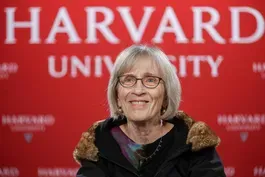
Why FDA approval of sickle cell gene therapy is a ‘big deal’
Clip: 12/9/2023 | 5m 8sVideo has Closed Captions
Why the FDA’s approval of revolutionary sickle cell gene therapy is a ‘big deal’
Sickle cell disease is a chronic, debilitating condition that affects nearly 100,000 Americans, most of them with African ancestry. Now, the FDA has approved a groundbreaking treatment for it that uses the gene-editing tool CRISPR. John Yang speaks with Yale School of Medicine assistant professor Dr. Cece Calhoun and New York Times reporter Gina Kolata to learn more.
Problems with Closed Captions? Closed Captioning Feedback
Problems with Closed Captions? Closed Captioning Feedback
Major corporate funding for the PBS News Hour is provided by BDO, BNSF, Consumer Cellular, American Cruise Lines, and Raymond James. Funding for the PBS NewsHour Weekend is provided by...

Why FDA approval of sickle cell gene therapy is a ‘big deal’
Clip: 12/9/2023 | 5m 8sVideo has Closed Captions
Sickle cell disease is a chronic, debilitating condition that affects nearly 100,000 Americans, most of them with African ancestry. Now, the FDA has approved a groundbreaking treatment for it that uses the gene-editing tool CRISPR. John Yang speaks with Yale School of Medicine assistant professor Dr. Cece Calhoun and New York Times reporter Gina Kolata to learn more.
Problems with Closed Captions? Closed Captioning Feedback
How to Watch PBS News Hour
PBS News Hour is available to stream on pbs.org and the free PBS App, available on iPhone, Apple TV, Android TV, Android smartphones, Amazon Fire TV, Amazon Fire Tablet, Roku, Samsung Smart TV, and Vizio.
Providing Support for PBS.org
Learn Moreabout PBS online sponsorshipJOHN YANG: This week, the Food and Drug Administration approved a revolutionary treatment for sickle cell blood disease, a chronic debilitating condition that affects nearly 100,000 Americans, most of them with African ancestry.
It's caused by an inherited genetic mutation that distorts the shape of red blood cells.
Yale Medical School assistant professor Cece Calhoun, specializes in caring for people with the disease.
CECE CALHOUN, Yale University School of Medicine: When I talk to patients, my especially my young adults who have sickle cell disease, they often tell me, it's a silent disease.
I feel unseen people can't see what it is that I go through what I'm trying to navigate.
And so, what in part, what this time represents is awareness.
And people seeing that sickle cell is real, starting to understand the way it affects people's ability to live life every day.
JOHN YANG: This is the first U.S. approved medicine for a genetic disease that uses the groundbreaking gene editing tool called CRISPR.
Gina Kolata in New York Times reporter who focuses on science and medicine.
Gina, how big a deal is this not just for the people who have sickle cell, but also for this technology, this gene editing technology.
GINA KOLATA, The New York Times: Is actually a really big deal for both for the people who have it, it offers them hope, because there really wasn't much hope before this, if a cure.
Now, most people are probably not going to get it.
It's expensive.
It's onerous, not everybody's going to be eligible.
But you can see sort of something on the horizon that maybe could make a difference change your life.
For CRISPR, it's also a huge deal.
Because one of the questions with CRISPR is, is it safe?
In this case, it's making a little cut in the DNA.
And the issue is how do you know a cut in the right place?
And that didn't start cutting someplace else to, how do you know you aren't disrupting another gene that might cause cancer, for example.
So what happened was the company Vertex and CRISPR therapeutics that make this treatment?
What they did was extensive tests saying, we're looking and looking to see if this treatment is disrupting other genes.
So in both cases, it means a lot to have this treatment approved.
JOHN YANG: You say not all people with sickle cell would qualify for this, what's the difference?
What would make someone ineligible for this?
GINA KOLATA: What happens with sickle cell is the red blood cells get deformed, and they get caught in blood vessels, and people have frequent episodes of really unbearable pain that send them to emergency rooms looking for opioids.
And often they're dismissed as drug seeking, they get hospitalized, it's totally debilitating.
In order to qualify, you have to have several of these episodes a year, then the other thing that could make somebody ineligible as if their doctor thought they could not tolerate the grueling treatment.
First, you have to have eight weeks of transfusions, when people are trying to take stem cells, immature cells out of your bone marrow, you have to go to the hospital and spend a month there.
First, they give you very intense chemotherapy to just totally wipe out your bone marrow, which is the source of your immune system, so that it's sort of cleaned out and ready for the gene edited cells that they're going to put in.
And then you have to wait for your bone marrow to grow back again.
And so you have you're pretty much without an immune system for a month.
And people who are frail, who've had a lot of other things go wrong with them, are not going to be able to tolerate it, at least in their doctor's opinion.
JOHN YANG: Now, the cause of sickle cell has been known for decades.
But research seems to have languished over these years.
Why do you think that is?
GINA KOLATA: People attribute it to a couple of things.
One of them is it was they knew what the cause was, but they didn't really know what to do about it.
So that was made it really difficult to try to figure out how do you treat this thing where you have one tiny change out of 3 billion DNA letters, one of them has changed and you have this awful disease.
But another reason is, there was not a lot of money poured into doing research on sickle cell.
There's a thought that that had a lot to do with the population that was that was affected, mostly black Americans, Hispanic Americans, many of them without much money.
And they didn't have a strong advocacy group.
People often compare it to cystic fibrosis, which strikes mostly white children.
And it's not as common as sickle cell.
But they had big fundraisers and telethons and lots of advocacy and people knew about cystic fibrosis.
And money poured in.
And there was a lot more research on cystic fibrosis than there was on sickle cell.
So I think that that's one reason that languished was simply that people kind of didn't care enough.
JOHN YANG: Gina Kolata, The New York Times.
Thank you very much.
GINA KOLATA: Thank you.
It's a pleasure talking to you.
Thanks a lot.
Nobel laureate Claudia Goldin on women in the workforce
Video has Closed Captions
Clip: 12/9/2023 | 7m 33s | Nobel laureate Claudia Goldin’s takeaways from her research on women and work (7m 33s)
What to know about Venezuela and Guyana’s territory dispute
Video has Closed Captions
Clip: 12/9/2023 | 7m 28s | What to know about escalations in Venezuela and Guyana’s territorial dispute (7m 28s)
Providing Support for PBS.org
Learn Moreabout PBS online sponsorshipSupport for PBS provided by:
Major corporate funding for the PBS News Hour is provided by BDO, BNSF, Consumer Cellular, American Cruise Lines, and Raymond James. Funding for the PBS NewsHour Weekend is provided by...













